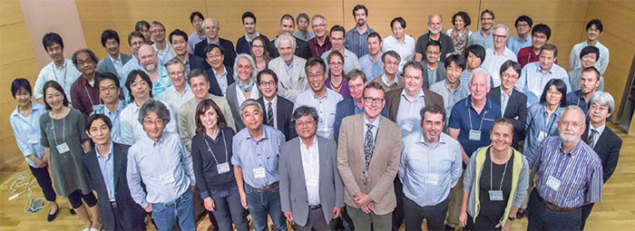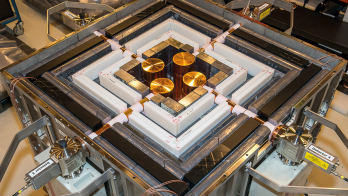T2K and Hyper-Kamiokande advance strong neutrino tradition.

Image credit: Kamioka Observatory, ICRR/University of Tokyo.
Japan has been a leader in the global neutrino community since the 1980s, breaking ground (both literally and figuratively) with multiple generations of massive underground experiments. These experiments, which although sited in Japan are built and operated by international collaborations, went on to make some of the most surprising discoveries in the history of particle physics. In doing so, they pointed the way to new experiments, and garnered the most prestigious accolades for Japanese physicists and their international partners.
Today, Japan is undertaking two major projects – T2K and Hyper-Kamiokande – to delve deeper into the neutrino’s properties. These and other global neutrino projects were the subject of discussions at the Third International Meeting for Large Neutrino Infrastructures, which took place at the KEK laboratory on 30–31 May (see panel below).
From Kamiokande to Super-K
Japan’s neutrino odyssey began with the Kamioka Nucleon Decay Experiment (Kamiokande), a 3000 tonne water Cherenkov experiment in the Kamioka mine in Japan’s Gifu prefecture, which started collecting data in search of proton decay in 1983. Although the experiment did not observe proton decay, it did make history with novel observations of solar neutrinos and, unexpectedly, 11 neutrino interactions from a supernova (SN1987a). These observations led to the 2002 Nobel Prize in Physics for Masatoshi Koshiba of the University of Tokyo, shared with the late Ray Davis Jr, and paved the way to a second-generation experiment.
Following Kamiokande’s success, in the 1990s, the late Yoji Totsuka led the construction of a 50,000 tonne water Cherenkov detector called Super-Kamiokande (Super-K). Like its predecessor, Super-K is also a proton-decay experiment that became famous for its measurements of neutrinos – both solar and atmospheric. Atmospheric neutrinos come from high-energy cosmic-ray interactions in the Earth’s atmosphere, predominately from charged-pion decays that result in a two-to-one mix of muon and electron neutrinos that can pass straight through the Earth before interacting in the Super-K detector.

Image credit: Kamioka Observatory, ICRR/University of Tokyo.
Although the cosmic-ray flux impinging on the Earth is isotropic, Super-K data indicated that the flux of atmospheric neutrinos is not. In 1998, the Super-K collaboration showed that muon neutrinos coming from above the detector outnumbered those coming from below. The muon neutrinos that travel from the other side of the Earth transform into tau neutrinos and effectively disappear, because they are not energetic enough to interact and produce charged tau particles. This process, called neutrino oscillation, can only happen if neutrinos have mass – in contradiction to the Standard Model of particles physics. The discovery of atmospheric-neutrino oscillations led to the 2015 Nobel Prize in Physics for Super-K leader Takaaki Kajita and also Arthur McDonald of the Sudbury Neutrino Observatory (SNO) in Canada, for the concurrent observations of solar-neutrino oscillations.
From KEK to Kamioka to T2K
Two new experiments, K2K and KamLAND, were built in Japan to follow up the discovery of neutrino oscillations. The KEK-to-Kamioka (K2K) collaboration built at the KEK laboratory an accelerator-based neutrino beam aimed at Super-K, 250 km away, and also a suite of near-detectors. The collaboration solved several technical difficulties to confirm that nature’s most elusive particle was being created in their accelerator beam and was definitely interacting in Super-K, with careful comparisons from the near detectors at KEK showing that some muon neutrinos were indeed disappearing as they travelled, just as the Super-K collaboration predicted.
The Kamioka Liquid Scintillator AntiNeutrino Detector (KamLAND) experiment was built in the cavern that originally held Kamiokande, and offered sensitivity to electron antineutrinos from Japan’s nuclear reactors. KamLAND found that the neutrinos were indeed oscillating in a manner exactly consistent with the solar-neutrino oscillation observed by SNO and Super-K. These two international experiments in Japan, K2K and KamLAND, confirmed that neutrino oscillations were the explanation for the surprising observations of Super-K and SNO. But all of these experiments had seen only the disappearance of neutrinos, and it was therefore time for an experiment to observe the appearance of neutrinos.
In 2009, the Tokai-to-Kamioka (T2K) collaboration, comprising 500 scientists from 11 nations, built an experiment to observe the appearance of electron neutrinos in a muon-neutrino beam. The concept is similar to that of K2K, but with higher beam power and higher precision in the near detectors. To achieve higher beam power, T2K uses the new accelerator complex at the Japan Proton Accelerator Research Complex (J-PARC) in Tokai Village on the east coast of Japan, about 70 km from KEK. The neutrino beam is directed in an off-axis configuration, which allows precise control of the neutrino energy spectrum, towards the Super-K detector 295 km away. In 2011, T2K reported the appearance of electron neutrinos from a muon-neutrino beam, which was the first significant neutrino-flavour appearance signal. For this result, which completed the picture of neutrino oscillations with the three known Standard Model neutrino flavours, T2K and K2K founding spokesperson Koichiro Nishikawa was awarded a share of the 2016 Breakthrough Prize in Fundamental Physics, along with all T2K and K2K collaboration members. The Super-K, KamLAND, SNO and Daya Bay collaborations also shared in the award.

Image credit: Patrick Dep/J-PARC.
As often happens in particle physics, the previous generation’s discovery becomes the current generation’s tool to search for new discoveries. In 2014, T2K began to operate with a muon antineutrino beam. By comparing oscillations of antineutrinos with oscillations of neutrinos, it might be possible to find a clue to one of the most profound mysteries in science: why does the universe appear to be composed entirely of matter, when it is believed that equal quantities of matter and antimatter were created in the Big Bang? Differences between the oscillations of neutrinos and antineutrinos could provide the answer to this, and, if they exist, these differences would be an example of CP violation (CPV).
In late June 2016, the T2K collaboration submitted a proposal to J-PARC requesting an extension of its neutrino (and antineutrino) data run that would give the collaboration significant (potentially 3σ) sensitivity to CPV by 2025. The physics reach of this extended run has been boosted by news that MEXT, the Japanese science funding agency, has approved the first step of an upgrade of the main-ring accelerator at J-PARC. This facility will house a new power supply system with which the repetition rate of the main ring will be doubled, resulting in 750 kW beam power for T2K with the potential to exceed 1 MW.
To Hyper-K and beyond
For discovery-level sensitivity to CPV (5σ or above), the next-generation water Cherenkov detector, Hyper-Kamiokande, is currently being designed. To reduce costs while maximising physics potential, the Hyper-K detector design has changed from the original concept of horizontal cylinders to vertical cylinders similar to Super-K, taking advantage of newly developed high-efficiency photo sensors. The international Hyper-K collaboration was formed in 2015, with agreements between the University of Tokyo’s Institute for Cosmic Ray Research (ICRR), which runs the Kamioka Observatory, and KEK.
Hyper-K, when exposed to the 1 MW J-PARC neutrino beam, will make precise measurements of neutrino and antineutrino oscillations as it searches for CPV with high significance, as well as perform the most sensitive searches for proton decay yet. Hyper-K construction could start as early as 2018, with physics data-taking in 2026. Combined with long- and short-baseline programmes in the US, Japan’s next generation of neutrino observatories should help physicists to answer most of the remaining questions about neutrino oscillations.
Planning ahead: Third International Meeting for Large Neutrino Infrastructures
 A major upgrade to the T2K experiment and the ongoing design of the Hyper-K detector were among many large neutrino projects discussed at the Third International Meeting for Large Neutrino Infrastructures, which took place at the KEK laboratory on 30–31 May. The event followed the previous instance of the meeting at Fermilab in April 2015 and aims to strengthen global co-ordination on large neutrino infrastructures, not just in Japan but the world over. The third meeting, which was organised by KEK, ICRR, Fermilab, the Astroparticle Physics European Consortium (APPEC), the ICFA Neutrino Panel and the IUPAP Astroparticle Physics International Committee (APPIC), evaluated progress made since last year, discussed strategy toward the realisation of next-generation large neutrino infrastructures, and reviewed the programme of supporting measurements, prototyping and R&D. The first day of the event addressed major accelerator-based programmes worldwide, focusing on Hyper-Kamiokande and the DUNE experiment planned in the US. The second day was devoted to examining the non-accelerator physics potential of the various large neutrino infrastructures, for which it was agreed that closer co-ordination is needed. Presenting progress towards its road-map document, the ICFA Neutrino Panel discussed long-term opportunities such as the Neutrino Factory and ESSnuSB. It also identified 2020 as the approximate date when the future of sterile-neutrino searches and cross-section measurement programmes should be defined, and recommended that experiments such as nuSTORM and IsoDAR be evaluated by then. It was proposed that the next “Infra” meeting be held in Europe in 2017.
|








